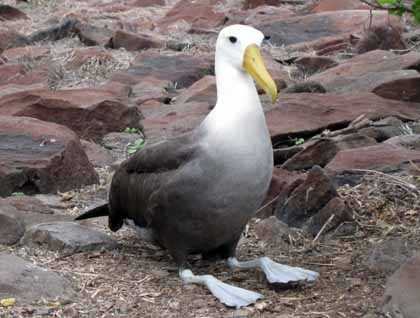Although geologically speaking Española is the oldest island, it’s one of the best places to observe the endemism of the archipelago and see exuberant life like nowhere else. The Española giant tortoise, the waved albatross, and the Española mockingbird are three of the endemic species that are only found on this remote island located at the southeast of the Galapagos.
Our first complete day in the archipelago began after breakfast. We headed by Zodiacs to Gardner Islet to snorkel along its clear waters, where we observed sting rays, a great number of colorful fish, and playful sea lions which captivated the attention of our guests. After deep water activities our guests landed at Gardner Bay to visit its beautiful coralline white beach, where imperturbable sea lions laid down resting after their long hours in the ocean swimming to catch some fish. We admired the tameness of the creatures found there - female sea lions nursing their pups, juveniles swimming along the shallows with us, and Española mockingbirds investigating our backpacks, trying to find some food or water.
In the afternoon and after a short navigation, the National Geographic Endeavour dropped anchor at Punta Suarez. With a soft drizzle and high tide we headed the Zodiacs to try to land on the small landing dock, but the big waves completely covered it. It was impossible to disembark over there, and therefore we had to land on the rocks beside a white beach. We crossed beside a group of marine iguanas warming their bodies on the rocks, while along the beach, sea lions tried to avoid the waves moving inlands on the rocks. Walking inland the vegetation was turning green as result of the last rainfalls, while along the trail female marine iguanas were digging holes, prepared their nests to lay the eggs far from the humid sandy beaches.
Along the rocky trail, we observed some Galapagos hawks, doves, and mockingbirds. Finally, we arrived at the waved albatross territory, where they captivated us with their unmistakable sounds, remarkable courtship dance, and by nesting their eggs. Along the cliffs Nazca boobies nested or fed their chicks while in the air swallow-tailed gulls, frigate birds, shearwaters, blue-footed boobies, and the huge albatross were the delight of our guests.
In the distance we heard the power of waves against the rocks. We approached the other side of the cliff to discover the spectacular blowhole where huge waves were breaking against the rocks, flooding the seashore with white foam. We stopped for a few minutes to observe that incredible formation, which just like a real volcano in eruption threw its energy high in the air.
It was almost 6:00 p.m. and the soft drizzle became a strong rain, humidifying the island and the bodies of thirsty mockingbirds. We heard their songs of happiness, and in our minds, the best memories of those innocent creatures will remain with us forever.




